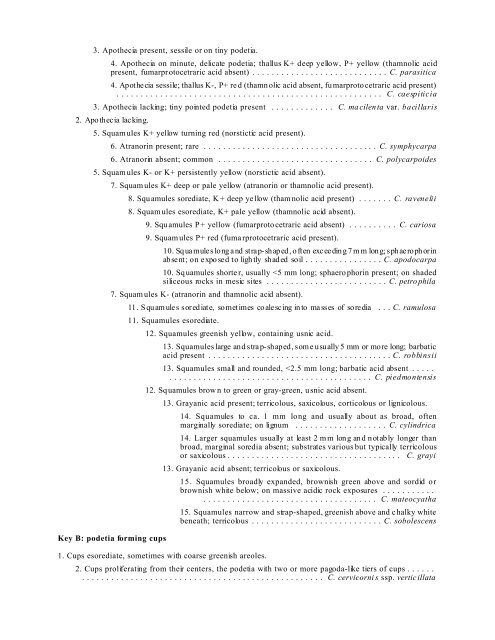lichens of the lower ozark region of missouri and arkansas
lichens of the lower ozark region of missouri and arkansas
lichens of the lower ozark region of missouri and arkansas
You also want an ePaper? Increase the reach of your titles
YUMPU automatically turns print PDFs into web optimized ePapers that Google loves.
3. Apo<strong>the</strong>cia present, sessile or on tiny podetia.<br />
4. Apo<strong>the</strong>cia on minute, delicate podetia; thallus K+ deep yellow, P+ yellow (thamnolic acid<br />
present, fumarprotocetraric acid absent) ............................C. parasitica<br />
4. Apo<strong>the</strong> cia sessile; thallus K-, P+ red (thamnolic acid absent, fumarprotocetraric acid present)<br />
....................................................... C. caespiticia<br />
3. Apo<strong>the</strong>cia lacking; tiny pointed podetia present ............. C. macilenta var. bacillaris<br />
2. Apo <strong>the</strong>cia lacking.<br />
5. Squamules K+ yellow turning red (norstictic acid present).<br />
6. Atranorin present; rare ....................................C. symphycarpa<br />
6. Atranorin absent; common ................................ C. polycarpoides<br />
5. Squamules K- or K+ persistently yellow (norstictic acid absent).<br />
7. Squamules K+ deep or pale yellow (atranorin or thamnolic acid present).<br />
8. Squamules sorediate, K+ deep yellow (tham nolic acid present) .......C. ravenelii<br />
8. Squamules esorediate, K+ pale yellow (thamnolic acid absent).<br />
9. Squamules P+ yellow (fumarprotocetraric acid absent) .......... C. cariosa<br />
9. Squamules P+ red (fumarprotocetraric acid present).<br />
10. Sq ua mule s lo ng a nd strap-sh ap ed , o ften exc ee din g 7 m m lon g; s ph ae roph orin<br />
ab sent; on e xpo sed to ligh tly sh ad ed so il ................C. apodocarpa<br />
10. Squamules shorter, usually


